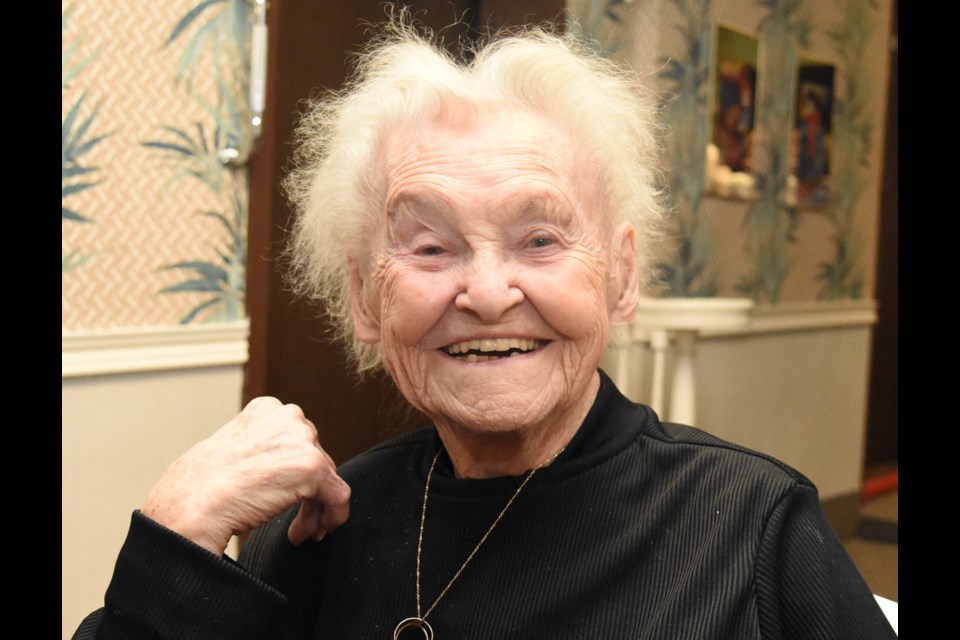There were only two job options for young people in Dundee, Scotland in 1942: work in a munitions factory or join the military.
Faced with those choices, Margaret Alm decided that wearing a uniform was better than toiling away in a factory.
“I thought it was beneath my dignity,” laughed Alm, now a sprightly 96.
Born on Dec. 9, 1922, Alm — née Cargill — was 19 years old when she enlisted.
It was the middle of the Second World War and the Germans controlled most of Europe. However, the year 1942 was also the high-water mark for the German military, as the momentum slowly began swinging in the Allies’ favour.
As for Alm, she joined the Royal Air Force’s Women’s Auxiliary Air Force (WAAF).
Although they did not participate in active combat, WAAFs were exposed to the same dangers as others on the home front. They were active in parachute packing and crewing barrage balloons, along with performing catering, meteorology, radar, aircraft maintenance, transport, and communications duties.
Alm was given the rank of Leading Aircraft Woman (LAC) and was made a bookkeeper in the equipment accounting section.
“It was something different I had to learn,” she said. “It was a different method of doing things. Sometimes the officers were not nice (to the enlisted people) … They thought they were the whole cheese and (were) dictatorial.”
However, her commanding officer, a Lt. Payne, was a pleasant officer for whom Alm enjoyed working.
Working as a bookkeeper was an interesting experience for Alm, who noted she made many friends from different places in the United Kingdom. There were four women — including her —in her office, while men made up the rest of the staff.
“It did have an effect on my life,” she said. “I was just glad to be alive. It was a difficult time to be a young person … It was a terrible time, but it was something we had learned to live with.”
One particular hardship was the food rationing, Alm explained. It was a scarce time and she couldn’t think of anything good to say about that aspect of her life.
Alm lived with other WAAFs in a barracks, but when given leave, stayed with her parents, William and Maggie, and sister Eleanor. Her brother David had joined the army and left home; he would survive the war.
“I was just always so glad to get my uniform off, just so I could be me,” she said.
Alm remained in the Royal Air Force until she was discharged in August 1945.
“When the war ended (in May), I was just glad to be home and out of the service … ,” she said. “There was real celebrations (everywhere). When you met people in the street, everybody was hugging you whether you knew them or not. They were just glad to see the war coming to an end.”
Margaret eventually married Andrew Alm and she followed him to Canada as a war bride. A Canadian, Andrew used to work for her uncle in Fort William, Ont. — now Thunder Bay — on a mink ranch, which at one time Alm believes was the largest in the world.
“It smelled something awful,” she chuckled.
Andrew joined the Canadian army as a gunner in the 17th Field Regiment and was posted to the United Kingdom. Since he had the Cargills’ address, he asked Margaret’s parents if he could visit her in Scotland while on leave. They begrudgingly said yes.
“And that’s where it all began,” she said beaming.
Andrew and Margaret moved to Fort William after the war, where he continued working on her uncle’s ranch.
Some years later, Andrew’s father came from Western Canada and asked his son to take over the family farm. His father explained that if they didn’t come, he would be forced to sell his farm to strangers.
So, the young couple packed up their belongings and took a train trip west, where they settled in Kelliher near Melville.
“It was the biggest mistake we ever made,” she exclaimed. “I had (such) a comfortable house in Fort William.”
Her mother-in-law — who was of Swedish descent — was also not kind to her and resented her. She even asked out loud why her son had to go so far from home to find a wife.
Decades later, the Alms moved to Moose Jaw. For nearly 20 years, Margaret served as a librarian in the community.
Andrew died in 1995. Margaret now lives at Chez Nous care home.
This story is one of many featured in our Remembrance Day supplement. You can read the issue online or pick up a copy at our office (32 Manitoba St. West).




